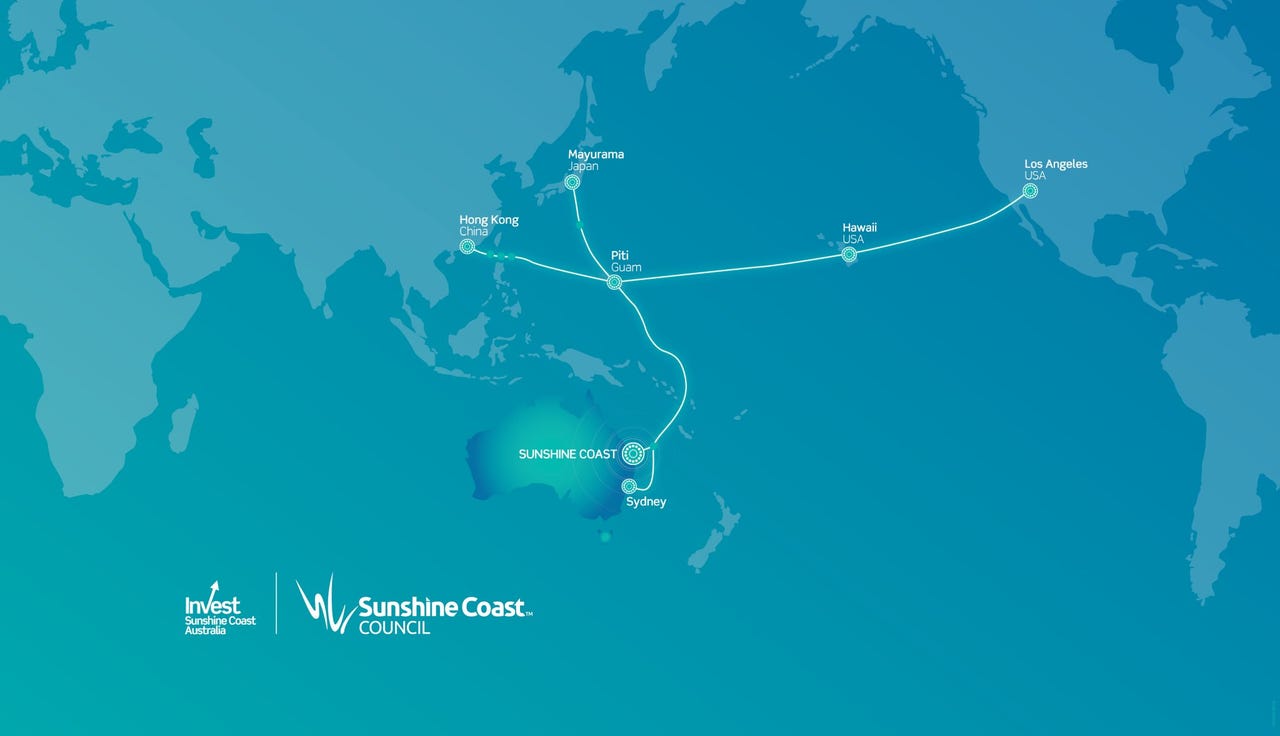Sunshine Coast Council makes AU$35m investment for local JGA cable landing


Sunshine Coast Council has invested AU$35 million into the Japan-Guam-Australia (JGA) cable system that will see a 550km extension land in the local government area at Maroochydore, situated around 100km north of Brisbane.
The council boasted that the investment -- alongside land-based infrastructure jointly funded by the Queensland government, which contributed AU$15 million to the cable landing -- would contribute to 864 new jobs and AU$927 million in new investment for the state, with Mayor Mark Jamieson saying those numbers were on the conservative side, and the landing was a "game-changer".
"The Sunshine Coast will provide the fastest, most affordable international connection point for Queensland and Australia to Asia, providing a significant step-change in Queensland's attractiveness as an investment location," Jamieson said.
"This project will stimulate investment and jobs growth on the Sunshine Coast thanks to the superior telecommunications connectivity and data infrastructure and could serve to attract some of the world's biggest data users to our region."
The mayor said local rate payers would benefit from customers paying to use the Sunshine Coast connection.
"Once again, our council is at the forefront of thinking outside the square, securing new revenue sources and pursuing opportunities to generate economic and employment growth as a major dividend for our residents, thus ensuring we continue to be Australia's healthy, smart, creative region," he said.
Jamieson pointed out that much of Queensland's communications head down to New South Wales before heading overseas.
"People don't realise that every time you make an international phone call or transfer data overseas, every time you search Google, every time you like something on Facebook, it doesn't go through a satellite," Mayor Jamieson said. "In fact, the majority of Australia's international voice and data traffic travels via submarine cables.
"To have all Australian east-coast international cables landing in Sydney is not only more expensive, it's a huge business and national security risk if those cables are damaged at the same time."
Sole developer of the north part of the JGA cable, and in league with AARNet and Google for the southern part, RCI said the Queensland landing would be quicker than the one in Sydney.
"This new path will deliver traffic into and out of Australia faster than the Sydney route because it is geographically closer to mainland China and Hong Kong, where there are over 1.1 billion people," RCI CEO Russ Matulich said.
"International submarine cables impact economies by increasing communications, trade and education. The higher the number of cables, the higher GDP per capita. And the more cables landing in a specific location improves the quality of life, not just for the local citizens but for the nation."
The cable extension is being constructed by Alcatel Submarine Networks, with the JGA cable due to be completed in the first half of 2020.
Earlier this week, due to an outage on the SEA-ME-WE3 cable, Vocus made its Australia Singapore Cable (ASC) ready for service despite still being in its final testing stage.
Vocus CTO Simon Smith on Wednesday approved the early activation of services, with engineers to continue working to "fully operationalise" the ASC by September 14.
"Even though we had announced Vocus ASC ready for service on September 14, our priority is ensuring our customers continue to access the connectivity they require. The SMW3 outage has forced our hand, but our testing on ASC is ahead of schedule and we are confident enough to press ASC into early service," Smith said at the time.
The 4,600km $170 million ASC is designed to carry 40Tbps at a minimum across four fibre pairs.
SUBSEA CABLES ACROSS THE GLOBE
- Vocus' Australia-Singapore Cable (ASC)
- Vocus' North West Cable System (NWCS) between Darwin and Port Hedland, and the new Tiwi Islands spur being added
- The Australian government's Coral Sea subsea cable, being constructed by Vocus to connect Australia, Papua New Guinea, and Solomon Islands and funded through the foreign aid budget
- Google's Dunant transatlantic subsea cable between Virginia Beach in the United States to the French Atlantic coast
- The Indigo subsea cable system
- The Indian government's Chennai-Andaman and Nicobar islands subsea cable, being built by NEC
- Southern Cross Cables' NEXT subsea cable system between Australia, New Zealand, and the United States, being built by SubPartners
- The Trident subsea cable system connecting Perth with Singapore via Indonesia
- The Jupiter subsea cable connecting the US, Japan, and the Philippines and being built by a consortium including Facebook, Amazon, SoftBank, NTT Com, PLDT, and PCCW
- The Hawaiki subsea cable between Australia, New Zealand, and the US
- Superloop's Hong Kong cable
- Telstra's Hong Kong Americas (HKA) cable between Hong Kong and the US
- Telstra's Pacific Light Cable Network (PLCN) between Hong Kong and the US
- Google's Japan-Guam-Australia (JGA) cable system
- The Asia-Pacific Gateway (APG) subsea cable connecting China, Hong Kong, Japan, South Korea, Malaysia, Taiwan, Thailand, Vietnam, and Singapore, owned by a consortium including China Telecom, China Unicom, China Mobile, NTT Communications, KT Corporation, LG Uplus, StarHub, Chunghwa Telecom, CAT, Global Transit Communications, Viettel, and VNPT, and being constructed by NEC
- The Southeast Asia Japan 2 cable (SJC2), which will have 11 landing stations in Singapore, Thailand, Cambodia, Vietnam, Hong Kong, China, South Korea, Taiwan, and Japan, being built by NEC and funded by a consortium including China Mobile International, Chunghwa Telecom, Chuan Wei, Facebook, KDDI, Singtel, SK Broadband, and VNPT
- The Bay to Bay Express Cable System (BtoBE), connecting Singapore and Hong Kong with the US, being funded by consortium including Facebook, Amazon Web Services (AWS), and China Mobile International, and being built by NEC